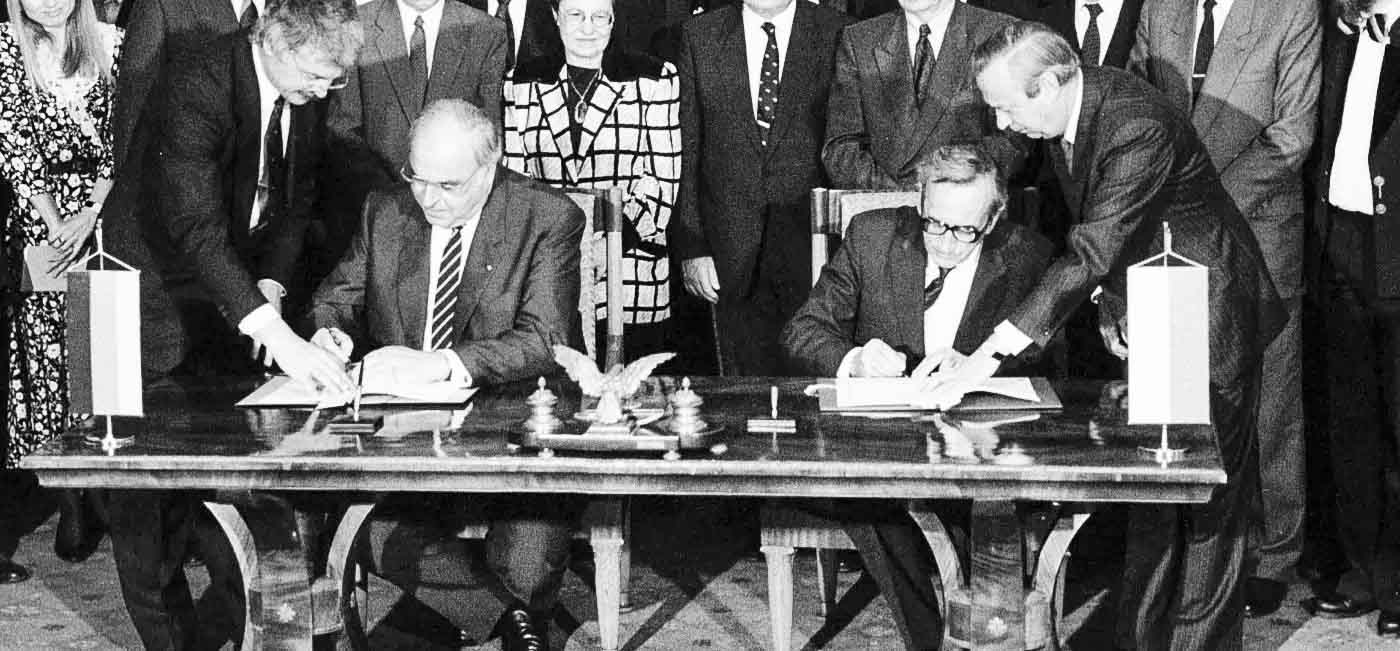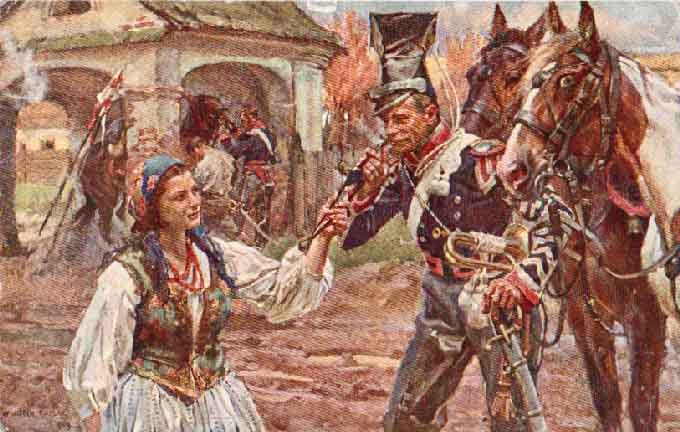For many years, Polish governments were not interested in properly nurturing the Polish history. Even now, the history taught in schools contains many understatements and fake "facts". Therefore, the historical awareness of many Poles today is limited to the symbolic commemoration of monuments and memorial sites, while the rest of the world has no idea what the terrible fate of the Polish nation was during the Second World War, and the crimes committed against the Poles remain in the shadow of the Holocaust.
From 1945, the German state used the opportunity to build its new history. Nazi crimes were considered redeemed, paid off, and no longer subject to criticism. We hear aggressive statements from some politicians from across the River Oder about the "expelled Germans."
The Nuremberg Trial
During the main Nuremberg Trial, which began on November 20, 1945 and lasted almost a year, Polish matters were treated very fragmentarily.
On August 8, 1945, four powers — England, France, the USSR and the USA — signed an agreement in London, according to which, it was decided that only they would take part in the Nuremberg trial and that they would represent other countries.
The Polish government, which decided to send its delegation to Nuremberg, had to attempt to gain status for it by a roundabout route already during the trial. However, the Polish delegation could not take part in the process formally, which was a severe blow to Poland, due to the number of personnel and material losses and the role of Poles fighting in the Allied forces.
The four victorious powers (including France!) prepared their indictment by September 1945, providing documents and testimonies of witnesses. In the indictment, the facts and documents concerning the robberies and atrocities committed in Poland by the Germans during the entire period of the occupation are not sufficiently taken into account. There is nothing in it about the devastation during and after the Warsaw Uprising. Documents confirming the barbaric intentions of the Germans towards Poland and Poles in the event of their [Germans'] winning the war are also omitted.
During this period, Poland was not represented in the United Nations Commission for War Crimes, as it was then that the Allied powers withdrew the recognition of the Polish Government in London. Due to the lack of official contacts between Poland and those international bodies that were preparing the Nuremberg Trial, Polish cases were not properly included in the main indictment.
The time for the preparation of the Polish indictment was very short and the government of the People's Republic of Poland was not able to prepare full documentation and testimony of witnesses so quickly. Poland did not yet have a complete account of losses or documents relating to the concentration camps. The document did not mention the terror over the population, mass street executions of Poles, the extermination of the Polish intelligentsia, and the economic destruction of the country.
The indictment of the Polish delegation was classified by the Tribunal only as evidence, while the Polish side expected that the files, documents and the register of German crimes that had been brought would be officially announced and attached to the indictment.
The delegation consisted of four members. They were Stefan Kurowski, Tadeusz Cyprian, Stanisław Piotrowski and Jerzy Sawicki.
The coordinators for individual cases were Aleksander Bramson, Manfred Lachs, Marian Muszkat, Jan Sehn and Mieczysław Szerer.
Nevertheless, the presence of the Polish delegation in Nuremberg was significant.
They worked under very difficult conditions with no support staff, no office, no funds, inside inadequate premises, while every American sergeant had a car at the time. The American staff in Nuremberg numbered almost 1,500 people, and the staff of other powers numbered several hundred.
The four Polish delegates made great efforts to ensure that as many Polish matters as possible were discussed during the trial. Thanks to their titanic work, it was possible to present evidence of Nazi crimes in Poland, of course to a limited extent.
Poland presented only two witnesses — Seweryna Szmaglewska, a prisoner from Auschwitz-Birkenau, and a tailor, a Polish Jew, Samuel Rajzman, a prisoner of Treblinka. There were supposed to be four witnesses, but one of them, Józef Cyrankiewicz, did not arrive on time, and the other, an excellent expert in these cases and director of the Historical Institute, who collected a huge amount of documentation and witness testimony, was disqualified by the Tribunal, because he was not a prisoner of a Nazi camp.
Unfortunately, I was unable to establish the name of this fourth witness. In response to my letter, the Institute of National Remembrance (Instytut Pamięci Narodowej, IPN) wrote that in order to obtain this information, an "extensive query" must be carried out. Besides, I need to find a scientist to support my request in writing. This testifies to the reluctance of the IPN towards people who are interested in history.
Ultimately, the indictment in the trial was based almost exclusively on official German documentation found in the archives of the Third Reich. In addition, the judgment was based on the testimony of the defendants, government documents of many countries, testimonies of witnesses, expert opinions, etc.
Needless to say, no crimes committed by the Soviet Union were raised in Nuremberg.
On the basis of my extensive searches and contacts with the Institute of National Remembrance, I conclude that the Polish indictment filed in Nuremberg in 1946 has never been published to the public in Poland, and it is possible that it is still classified.
In January 1947, the War Compensation Bureau at the Presidium of the Council of Ministers [of Poland] issued a special document entitled "Report on Polish War Losses and Damages in 1939-1945". This document was to be the starting evidence for the assessment of Poland's reparation claims against Germany. It was created in the first years after the war and contained underestimations. The document did not cover the eastern territories of pre-war Poland, i.e. our Borderlands, which, as a result of the Potsdam Conference arrangements, were transferred to the Soviet Union. The disadvantage of this document was the frequent reporting of losses in zlotys according to the 1939 exchange rate, which made subsequent monetary assessments very difficult.
The Polish Nation
The hostile German occupation of the Polish lands lasted longer than in other countries fighting against Germany. The ultimate goal of this occupation was the complete destruction of the Polish nation and leaving its remnants without property and national identity as a servant people to the German nation. The Polish territory was to create a living space for the Germans, and they would become the rulers of Europe. During all the years of the war, Poles were killed, persecuted and exploited, and the country was consistently destroyed. They died in concentration camps, and almost two and a half million people were deported to Germany for forced labor. The mass abduction of Polish children took place throughout the territory of occupied Poland. Thousands of intelligentsia, scientists, artists and priests died.
The caloric value of food products intended for Poles was about 400 to 700 calories, so it was several times lower than the minimum necessary for human survival.
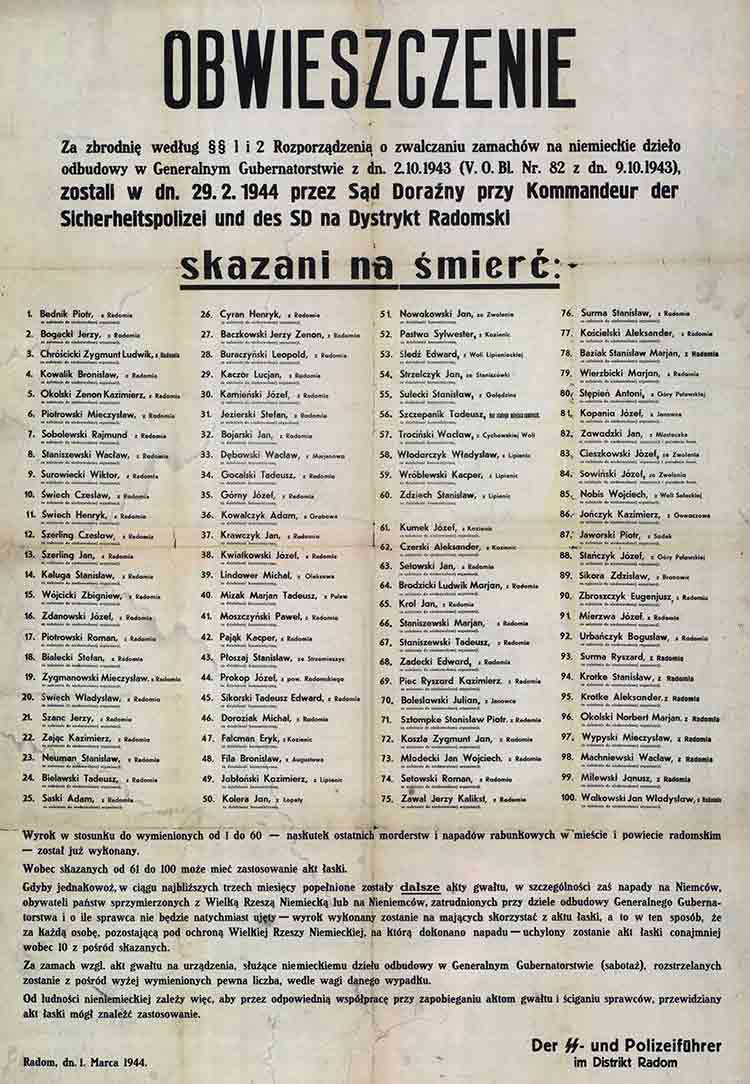
Announcement poster about the execution of Poles in February 1944
As early as on February 6, 1940, Governor General Hans Frank spoke cynically about the poster [published] by the Protector of Bohemia and Moravia, Konstantin von Neurath, in which it was announced that seven Czech students were shot: "If I were to publish a poster every time seven Poles are shot, there wouldn't be enough forests in Poland to make the paper for these posters."
Bombardments
At a secret conference with the commanders of the Wehrmacht on August 22, 1939, Hitler ordered the "complete destruction of Poland".
The September campaign in 1939 did not last long, but left huge losses.
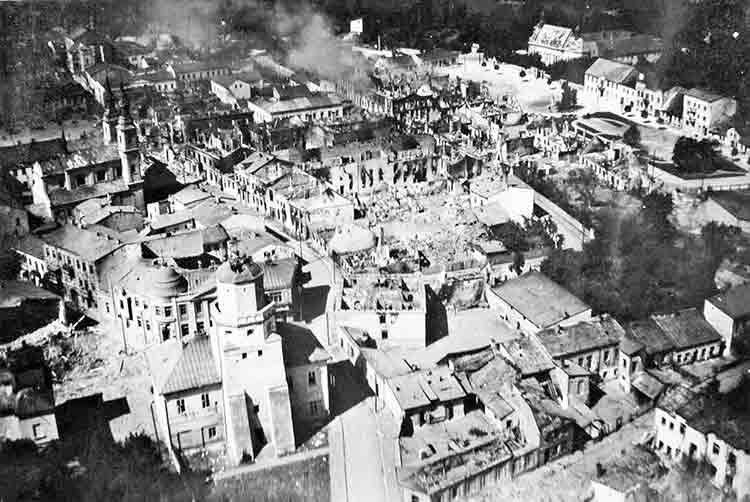
The City of Wieluń, after an air raid in 1939
The German air force bombarded the cities. The largest battles in regions such as Kutno, Modlin, Warsaw, Hel, the Narew region, part of Pomerania, and others left behind great destruction. The attack of the Germans did not only affect military facilities, but was also directed at civilians and civilian installations. From the very beginning, thousands of civilians were shot, incl. in Bydgoszcz. Warsaw was heavily bombed.
Almost 70,000 soldiers and tens of thousands of civilians died in the September campaign.
The air bombardments in the following years did not bring great losses until 1944, when fights between the German and Russian armies, along with the Polish army, broke out on Polish territory. This period of the war again brought enormous losses again.
In 1944, after the uprising, Warsaw was almost completely destroyed. The industrial cities of Białystok, Poznań, Grudziądz, and dozens of larger and smaller towns were seriously damaged. Buildings were burned down and fields mined.
The Division of Poland
Already at the beginning of the war, the territory of Poland was divided by the Germans into several occupation zones. Upper Silesia was completely annexed to the Reich. The areas located in the West and North of Poland, mere tens of kilometers from the Western and Northern outskirts of Warsaw, were classified as Neu-Reich (New Reich) and also incorporated into the Reich. From the rest of Poland, the General Government was created, which included such cities as Warsaw, Krakow and Lublin.
From the first days of the occupation, the Germans almost completely removed any Poles from managing the country. Only here and there were Poles employed in secondary positions, without any political significance.
The occupant split the population into various national groups. A group of Volksdeutsche (German folk) was created from people of German origin and received many privileges. Ukrainian, Russian and Belarusian groups were granted similar privileges. Attempts were made to create a fictional highlander group. A massive Jewish group was separated, and as the occupation progressed, it was placed in ghettos and concentration camps, where it was being biologically destroyed.
From the lands incorporated into the Reich, from the first few months of the occupation, the Polish population was ruthlessly driven out and deprived of all property, including personal items. About a million Poles were displaced from there to the General Government, and many others were deported to work in Germany. The remaining small proportion of Poles, deprived of the opportunity to learn and practice religion, was evicted from their apartments to basements and cellars, and became slaves of the Germans.
On August 8, 1942, in the occupation newspaper Warschauer Zeitung, it was announced: "Our task is to ensure that only people of purely German, Germanic blood live on the eastern border."
Plunder and Destruction
From the very beginning of the war, the German policy aimed at exporting all raw materials and equipment useful for the Reich's economy and keeping Poland at the lowest possible level of economic and intellectual life, which was to prevent the revival of the Polish intelligentsia. The Germans destroyed cultural monuments, library collections, archives, and professional equipment. The losses that Poland suffered in this respect during the occupation are immeasurable. Even many German documents testify to the hatred and premeditation with which the Germans destroyed Polish cultural values. Buildings and monuments were demolished. Books were burned or sent to be ground. Entire libraries and archives were burned. Even for this war, the extent of the damage was completely unique. Nowhere else have cultural monuments been destroyed with such ferocity.
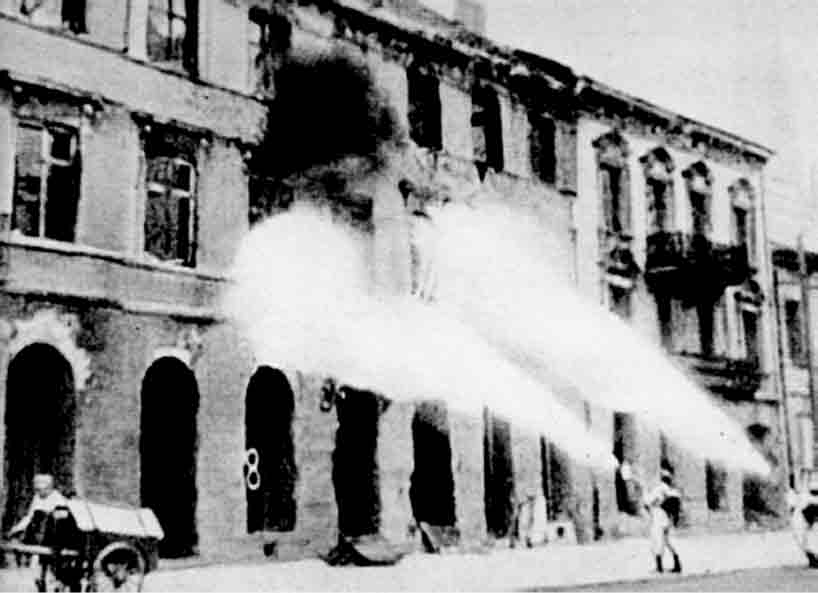
Systematic burning of the city of Warsaw by the Verbrennungskommando (Burning Detachment) after the 1944 Warsaw Uprising
At the same time, there was a gigantic looting of cultural works, that is, what the Germans called "securing" them. Throughout the entire period of the war, the confiscation of human property continued, without a judiciary protocol and without receipts. Wit Stwosz's altar taken from the St. Mary's Church in Krakow shown at the exhibition in Berlin, drawings by Durer from the Ossolineum, a painting by Honorato Daumier from the Warsaw Zachęta, old prints from the Warsaw university library — these are just a few examples of this theft, which swept the vast majority of public collections and large amount of private art collections.
Throughout the long period of occupation, this thoroughly deliberate plan deprived Poles of cultural life. They were not allowed to visit museums, theaters or libraries.
Only the German press existed, and the printed books concerned economic guides and very vulgar "bestsellers". Higher education was banned. The educational level in schools was very low. It included only basic subjects and knowledge of the trades. In the territories incorporated into the Reich, all Polish schools were closed. An attempt to re-start the University of Krakow in the fall of 1939 resulted in the perfidious deportation of a whole group of professors to the concentration camp in Sachsenhausen, where many of them died.
Great damage was caused by the closure of the Bank of Poland (Bank Polski) and the establishment of the, so called, Bank of Issue in its place. This involved the forced exchange of Bank Polski banknotes for worthless paper money released by the Germans. This action was contrary to the principles of international law. The monetary machinations of the occupiers disrupted the financial system. This new bank has technically made it easier for Germany to loot many valuables away from the country.
The Germans introduced forced deliveries from peasant farms, of which only a small part were intended for the needs of the Poles. The peasants were shot to death for failure to complete these deliveries. The wages of working Poles were several times lower than the wages paid for the same work to the Germans.
Warsaw
Warsaw was the most damaged city during the war. The Germans planned to reduce the number of inhabitants from about 1.3 million to 100,000.
After the bombing in 1939, the final destruction of the city took place after the Warsaw Uprising in 1944 and the complete removal of the population.
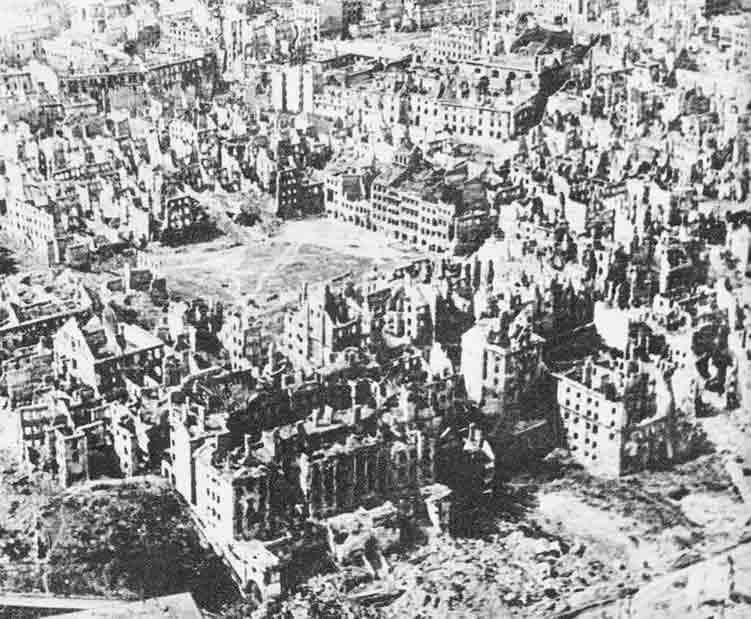
Warsaw, destroyed after the 1944 Uprising
The Royal Castle was already destroyed in 1939-1940. At that time, the floors, marble, sculptures, stone decorations, and cornices were dismantled and valuable collections were stolen. Most of these relics were taken to Germany, while some of them became the decoration of the palaces of German dignitaries in Poland. Even then, holes were drilled to blast the castle's walls. Ultimately, the castle was blown up in 1944. After the fall of the uprising, the Germans ruthlessly demolished everything that remained in Warsaw — churches, palaces, houses and monuments. It was a clearly malicious destructive action carried out on an order from Berlin to raze Warsaw to the ground.
Despite the terrible living conditions of Poles during the occupation, the population did not submit to the enemy anywhere. Poles fought in their country, fought on the seas of the world, in the mountains of Norway, in the fields of France, in the air over England, in the Soviet Union, in Africa, Italy, the Netherlands and Germany. The Polish underground fought throughout the occupation. These were military formations, units of the Home Army, National Armed Forces, People's Army, Peasants' Battalions, and other smaller formations. Secret education was conducted from the lowest to the highest levels. The underground press was published in thousands of copies, as well as secret book editions.
“The losses suffered by Poland were not and could not be the work of the criminal mentality of one man or even of a group of people like the Nazi party. Hitlerism worked out the idea and plan of destruction — the German people carried out this plan with complete unanimity. Hitlerism only revealed and intensified to the highest degree the tendency which had been inherent and carefully cultivated in the German nation since the times of Frederick the Great — the tendency to build an empire and prosperity of the German nation on Polish soil.”
"The victory of the allies saved the Polish nation from extermination, but the almost six years of tormenting it caused such great gaps in every area that no account is able to fully reflect the consequences that result from it. Only certain material fragments can be counted." [Quotations from the Report of the War Compensation Bureau 1947]
The following data was published by the War Compensation Bureau in 1947:
The Loss of Human Life
It should be noted that the report did not include the biological losses of Poles in the eastern territories of Poland, which had been seized by the USSR.
- Total loss of life in Polish society: 6,028,000, including about 3 million Jews.
- Loss of life in cities: 4,756,000, in villages: 1,272,000
- Loss of life due to hostilities: 10.7%
- Loss of life due to invader terror: 89.3%
- Infirm: total 590,000 (cities: 437,000, rural: 153,000)
- Poles deported to work: 2,460,000 (not including deportation of Poles by the Russians)
- The killed losses per 1000 Poles amounted to 220 people. In Yugoslavia it was 108 people, in the Soviet Union 40 people, in France 15 people and in England 8 people.
- Loss of child births: 1,215,000
- 5,000 doctors, 2,500 dentists, 4,500 lawyers, 5,562 teachers, 2,647 priests, 6,124 railwaymen, 2,412 postal workers, 700 professors and university employees, 235 artists, 104 actors, directors and others died.
Material losses
- Schools of various types destroyed: 6.152
- Hospitals destroyed: 352
- Health centers and doctor's offices destroyed: 2.299
- Radio receivers 867.700 destroyed
- Destroyed museums: 25
- Destroyed cinemas and theaters: 700
- Locomotives destroyed: 2,465
- Railway carriages destroyed: 89,892
- Seagoing ships destroyed: 25
- Coastal Ships destroyed: 39
- Telephone sets destroyed: 243,250
- Timber felled and plundered in square meters: 75,000,000
The War Compensation Bureau report submitted in 1947 was prepared in a very short time and on the basis of documents that were available at the time.
Certainly the numbers of losses and damage done by the Germans during the Second World War were much, much greater.
After the War
At the end of World War II, Poland found itself in a tragic situation.
Due to the lack of living space, people had to stay in overcrowded rooms, often without water, electricity and basic sanitation. Demolished cities had to be cleared of rubble before the construction of new housing projects began. Destroyed livestock and devastated Polish villages had to be recreated.
About one-and-a-half million people with tuberculosis and half a million disabled people unable to work put an additional strain on the economy. The great advancement of diseases such as tuberculosis and nervous diseases was reflected in a huge increase in mortality after the war. Infant mortality has also increased.
Millions of Polish citizens died, and the majority of them were young, able to work. The effects of the war left Poland for having to rebuild its existence and strength for many years.
The estimated population of Poland on September 1, 1939 was 35,100,000. In February 1946, this number was 23,930,000 people. From this it follows that the population decreased by 11.2 million. The population of 1946 also includes the population of the "recovered territories" [today's Western Poland] — about 3-3.5 million people. After subtracting this number, it turns out that the actual loss of the Polish population after the Second World War amounted to 14.2 million people.
The number of children not born because of the war was 1,215,000.
The numbers of personal and material losses reported today that Poland suffered during the German occupation are surprisingly similar to those of 1947, and the values of losses are still often calculated in zlotys according to the exchange rate in September 1939. And yet the War Compensation Bureau itself admitted then that the data was underestimated and not fully collected.
We now know much more about the Soviet occupation than about the German occupation. The number of young academics interested in the German occupation is rapidly declining. The question is, are they the ones who make this choice?
All photos: Wikipedia.
Translated from Polish by Andrew Woźniewicz.




